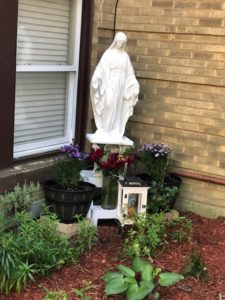 “I don’t remember this always being here.”
“I don’t remember this always being here.”
This thought seeped into my mind as I took my morning walk a few weeks ago and saw a shrine of sorts nestled between a couple brick three-flats just east of my building. Once I saw it for the first time, I started looking for it whenever I ventured by foot in that direction.
At first, I studied what I saw. Then, it became natural for me to interpret the scene, to develop a story, a way of explaining it to myself that was plausible and meaningful.
The assortment of objects included a white statue of Mary, modestly dressed in loose robes, her hair covered. Her hands hung gently to her sides, open but not outstretched. Her posture spoke of acceptance and compassion.
A couple planters, containing small purple flowers and an inexpensive glass vase holding a handful of red roses, brown on their edges, took up space at the foot of the statue. At Mary’s feet, standing off the ground, was a white lantern with a glass door.
At first, I thought it contained a picture of Jesus, but, on closer examination, I saw that Jesus’s face was on the front of a votive candle, which explains why I saw a flickering light coming from that direction when I took my dog for a walk at night.
Ah, someone is grieving in that household, I concluded.
I don’t like to use the word, “grief.” Rather than a feeling or behavior, the word makes me think of being stuck in the idea of its expression.
I imagined the family that assembled and displayed the shrine were Hispanic, Our Lady of Guadalupe, Mary, an especially significant figure in their traditions.
I didn’t get the feeling that the person who died was lost suddenly or in an accident. These days, It’s hard not to consider the possibilities of a COVID casualty. I thought about times when I saw bicycles, spray-painted in white or roadside markers, laden with plastic flowers, consecrating the spot where someone got hit by a car or truck.
Seeing this little shrine moved me. It felt that an important rite was taking place. It was for the family of the soul who ended his journey on earth, but it also felt like the display was for everyone, for anyone who had lost someone or something and didn’t completely grieve, didn’t fully embrace their feelings about the loss.
It was clear that this person was missed and would continue to be missed at birthdays and graduations and other family occasions.
His absence would be felt by the those who saw him every day, observing him partaking in a favorite ritual, maybe flipping open a can of beer, cerveza, after work or sitting in a favorite chair.
For several years, in October or November, I have gone to the National Museum of Mexican Art in Chicago’s Pilsen neighborhood to walk through their Day of the Dead exhibit. I would take in individual ofrendas, homemade altars made to honor someone who died, and try to get to know the person being mourned.
Often, these displays include flowers and candles, maybe maps of their life’s journey, cherished possessions. Sometimes I’d see guitars or wedding pictures, or union cards. In these little scenes, like dioramas on steroids, I could see a person’s hopes and dreams and what was ultimately accepted as the life they grew into.
I’d see what drove a person or inspired him. I’d get a sense for the grieving the person being honored might have known himself, giving up thoughts of playing the guitar or vihuela professionally, painting political murals or leading marches for workers’ rights. Eventually, most people settled for a life revolving around family, Sunday afternoons at a park or soccer field, holidays at the church.
I thought about how popular the Disney movie, Coco, was, how important the process of making peace with mortality is; the comfort that can be derived from knowing, after finishing your stint on earth, you will live on in someone’s heart.
Even though I’m not Christian and have no special relationship with Mary, I liked the idea of having this shrine just a few doors away. I liked thinking that someone was honoring his emotions and taking time with his feelings.
Grieving fully and deeply so that you can move on, wholeheartedly embracing life, is no small thing.


Leave a comment